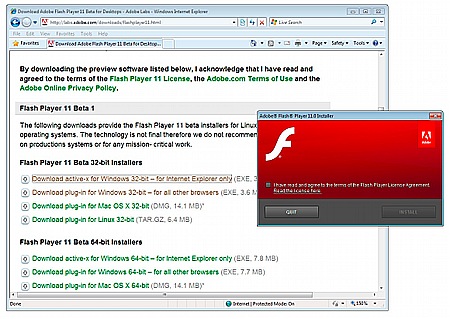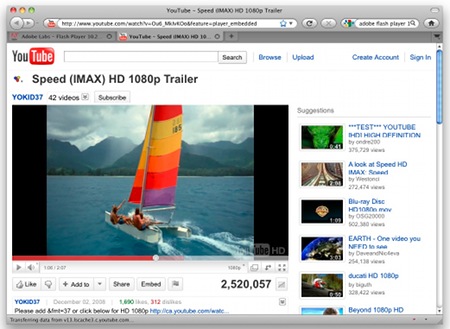Adobe evades Flash limitations by taking to the AIR
Sep 21, 2011 — by LinuxDevices Staff — from the LinuxDevices Archive — 3 viewsAdobe announced Flash Player 11, touted as delivering “a new class of gaming and premium video experiences” via hardware-accelerated 3D graphics. Conceding that the browser-based Flash isn't supported on Apple's iOS or Windows 8's Metro-style interface, the company added that its AIR runtime will be — bringing support to more than 200 million smartphones and tablets by the end of this year.
Adobe's Flash Player is described as a "a cross-platform browser-based application runtime that provides uncompromised viewing of expressive applications, content, and videos across screens and browsers." Once associated mainly with interactive ad banners and simple games, it has become a mainstay of web video, offered by sites like Hulu, YouTube, and countless others.
Flash Player 11 had been available in a Flash Player Incubator version, and it moved to a full public beta as of July 13. Adobe announced the software again Sept. 21, though it didn't provide a date on which it will ship the final code. (A release at or before Adobe's annual Max conference in October can reasonably be expected.)
The features being promoted for the new Flash Player release are essentially the same ones that were advertised back in July, as we review later in this story. But the browser-based Flash technology is facing new challenges from the evolving HTML5 standard.
Famously, Apple CEO Steve Jobs precipitated Flash's decline by nixing the technology from the iPhone and iPad and saying HTML5 would be ample for the devices' multimedia needs. Since then, a Flash Player that Adobe promised for Windows Phone 7 at its MAX 2010 conference has failed to appear, and now, Flash support has been removed from the Metro-style Internet Explorer provided in Windows 8.
Microsoft's Dean Hachamovitch, who leads the IE team, blogged on Sept. 14 that "running Metro style IE plug-in free improves battery life as well as security, reliability, and privacy for consumers." Noting that 62 percent of top websites use Flash today, he added that "many already fall back to HTML5 video in the absence of plug-in support."
Taking to the AIR
Adobe has responded by releasing Edge, an animation tool that makes nice with HTML5, JavaScript, and CSS (cascading style sheets). But the company's Sept. 21 announcement also played up AIR 3, the latest version of a runtime that "enables developers to use HTML, JavaScript, Adobe Flash and Flex technologies, and ActionScript to build web applications that run as standalone client applications without the constraints of a browser."
As well as supporting the same Windows, Mac OS, and Android platforms that Flash does, AIR is able to support Apple's iOS and the BlackBerry Tablet OS, according to Adobe. There will also be a version of AIR for the Windows 8 Metro UI, the company suggested in a Sept. 15 blog posting.
While the Linux-based Android is supported, AIR 3.0 does not support desktop Linux, as the company revealed in July. Adobe said that OEMs are free to go ahead and develop the Linux version, but in the meantime, the last Linux-ready AIR is version 2.6. So far, we've heard of no OEM plans to jump in.
New features promoted for Flash Player 11 and AIR 3 by Adobe include:
- accelerated 2D/3D graphics — Full hardware-accelerated rendering for 2D and 3D graphics enable 1,000 times faster rendering performance over Flash Player 10 and AIR 2. Developers are able to animate millions of objects with smooth 60 frames per second rendering and deliver console-quality games on Mac OS, Windows and connected televisions.
- AIR native extensions — With support for thousands of highly-optimized, open-source libraries, developers are able to tap into unique software and hardware capabilities including access to device data, vibration control, magnetometers, light sensors, dual screens, near field communication (NFC) and more.
- captive runtime — Developers can automatically package AIR 3 with their applications to simplify the installation process on Android, Windows and Mac OS in addition to Apple iOS. Users no longer have to download and update AIR separately on any of these platforms — or on BlackBerry Tablet OS, which includes AIR built-in.
- content protection — Premium video content can now be protected using Adobe Flash Access 3 across all supported platforms.
- HD video quality across platforms — Full frame rate HD video can now be displayed within AIR applications on Apple iOS devices using H.264 hardware decoding. Rich applications on televisions are also able to deliver HD video with 7.1 channel surround sound.
- rental and subscriptions support — With support for Adobe Flash Access and Adobe Pass, content publishers can take advantage of rental and subscription options and offer TV Everywhere content to more than 80 percent of U.S. pay TV subscribers
According to Adobe, Flash Player is supported on more than 98 percent of Internet-connected PCs today. The company adds that by the end of 2011, more than 200 million smartphones and tablets will support Flash-based applications via AIR. It's said the number of devices that will support Adobe AIR is expected to increase to 1 billion by the end of 2015.
More about the Flash Player improvements
While HTML5 and AIR may be the way forward — whether Adobe wanted it that way or not — it's the improvements to Flash Player that will affect the vast majority of users this year.
We commented in July that it seems Linux users will be the most to gain from the new release, since Flash Player 11 includes both 32- and 64-bit support for that operating system (as, once again, it also does for Windows and Mac OS). In addition, vector printing — for "crisp and sharp" images — is now supported on Linux as well as the other two platforms, according to Adobe.

Installing Flash Player 11
(Click to enlarge)
Flash Player 11 is also said to include Stage3D APIs, previously codenamed "Molehill." These provide "a new method/model of 2D and 3D rendering" that will provide developers "the flexibility to leverage GPU hardware acceleration for significant performance gains."
According to Adobe, Flash Player 10.x was capable of rendering thousands of non z-buffered triangles at approximately 30Hz. Once they adopt the new Stage3D APIs for Flash Player 11, developers can expect hundreds of thousands of z-buffered triangles to be rendered at HD resolution in full screen at around 60Hz, the company claims.
Adobe says Flash Player 11 also includes G.711 audio compression for telephony, plus H.264/AVC software encoding for video. The former supports interoperability with legacy phone system (through the Flash Media Gateway) and other third-party clients (through the RTMP protocol) without transcoding; the latter provides improved compression and "industry-wide support" for streaming video from a computer's camera, the company adds.
More programmer-oriented new features are said to include:
- JSON (JavaScript Object Notation) — allows taking existing code written for the JSON interface provided by ECMAScript 5th edition and dropping the code, with minimal or no modification, into an Actionscript project
- Garbage Collection Advice — provides a simple facility with which AS3 code can advise the GC on when to schedule the disruptive end-of-GC pause
- Socket Progress Events — provides a means by which content can determine how many bytes remain in the AS Socket's write buffer
- Secure Random Number Generator — generates secure random numbers that are cryptographically as strong as the underlying operating system; will be used on both desktop and mobile platforms by Flash Platform Services
Previous Flash Player versions
Last February, Adobe released a final version of its Flash Player 10.2, touting new features such as support for full-screen mode on multiple monitors and support for more GPUs. According to AMD, it worked with Adobe to enable accelerated 1080p video decoding on the E-Series and C-Series APUs ("advanced processing units") that have been making their way into notebooks and a variety of embedded products.
At the time, Adobe said Flash Player 10.2's enhanced performance on the AMD APUs, as well as the other supported GPUs, was due to Stage Video, "a new method for video playback." This "dramatically decreases" processor usage and also lowers the amount of RAM flash requires, the company claimed.

A demonstration of Adobe's Flash Player 10.2 playing back 1080p video
(Click to enlarge)
Other improvements in Flash Player 10.2 included the ability for developers to define custom native mouse cursors, security enhancements, and improved text readability, according to Adobe. Flash Player also now takes advantage of hardware-accelerated graphics in Internet Explorer 9, "utilizing hardware rendering surfaces to improve graphics performance and enable seamless composition," the company said.
According to Adobe, Flash Player 10.2 dropped support for Windows 2000 and PowerPC-based clients. The latter was because of "performance enhancements that cannot be supported on the older PowerPC architecture," the company says.
The company's previous Flash Player 10.1, was released in 2010. A key addition at the time was hardware decoding of H.264 video on computers using GPUs from AMD/ATI GPUs (Radeon HD and FirePro), Broadcom (Crystal HD BCM70012 and BCM70015), Intel (GMA500, 4 Series chipset, 2010 Core processors), and Nvidia (GeForce, Ion, and Quadro). At the time, however, GPU assistance wasn't available either on Linux or Mac OS X desktops.
Further information
The Flash Player 11 beta, which was last updated Sept. 6, can be downloaded now from Adobe's website, and so can release notes in PDF formats.
Jonathan Angel can be reached at [email protected] and followed at www.twitter.com/gadgetsense.
This article was originally published on LinuxDevices.com and has been donated to the open source community by QuinStreet Inc. Please visit LinuxToday.com for up-to-date news and articles about Linux and open source.